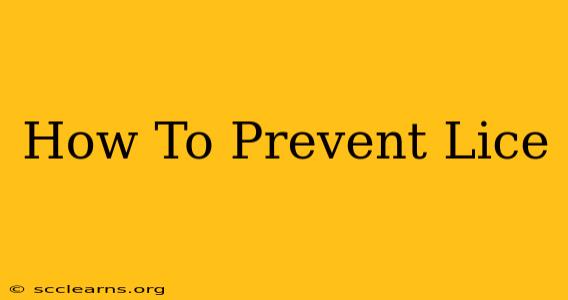Head lice are tiny parasitic insects that infest the human scalp, causing itching and discomfort. While not a serious medical condition, they can be incredibly bothersome and challenging to eliminate. This comprehensive guide will walk you through effective strategies to prevent head lice infestations in your home and family.
Understanding Head Lice
Before diving into prevention, it's crucial to understand how head lice spread. Lice are transmitted primarily through direct head-to-head contact. This means close proximity, like hugging or sharing hats, is the most common way lice spread. While they can't jump or fly, they can crawl from one person to another. Sharing personal items, such as combs, brushes, hats, scarves, and headphones, also poses a risk.
Mythbusting: Head Lice and Cleanliness
Contrary to popular belief, head lice infestations are not related to poor hygiene. Clean hair is just as susceptible as unclean hair. Focus on prevention strategies rather than worrying about cleanliness as a preventative measure.
Effective Prevention Strategies
Here are some highly effective ways to prevent head lice infestations:
1. Regular Head Checks
Regularly inspect your child's (and your own) hair for lice and nits (lice eggs). Part the hair in sections and carefully examine the scalp and hair shaft. This proactive approach allows for early detection and treatment, minimizing the spread. Aim for weekly checks, particularly during outbreaks at school or daycare.
2. Avoid Head-to-Head Contact
Encourage children to avoid close contact with other children's heads. This includes playing games involving head-to-head contact, sharing hats, or using the same combs and brushes. While difficult to completely avoid, minimizing contact significantly reduces the risk.
3. Don't Share Personal Items
Never share personal items like combs, brushes, hats, scarves, headphones, hair ties, or bedding with others. These items can easily harbor lice and their eggs. Encourage your children to keep their belongings separate from others.
4. Proper Hair Care
Keep long hair tied back to minimize contact with other people's hair. Braiding or twisting long hair can also make it harder for lice to crawl through.
5. Educate Your Children
Teach children about head lice and the importance of preventing infestations. Explain how lice spread and emphasize the importance of not sharing personal belongings. This education empowers them to take an active role in prevention.
6. Home Treatments
While not a preventative measure in itself, knowing the treatment options is crucial. Over-the-counter lice shampoos are readily available. However, always carefully follow the instructions and, if necessary, consult a doctor or pediatrician for more severe infestations.
Dealing with a Lice Infestation
Even with preventative measures, infestations can still occur. If you suspect an infestation, act quickly. Follow these steps:
- Thorough Inspection: Carefully examine the scalp and hair for lice and nits.
- Treatment: Use an over-the-counter or prescription lice treatment as advised by a healthcare professional.
- Cleaning: Wash all bedding, clothing, and other potentially infested items in hot water and dry them on high heat.
- Comb Out: Use a fine-toothed nit comb to remove any remaining lice and nits.
Remember: Early detection and prompt treatment are key to minimizing the spread of head lice and preventing long-term issues.
Conclusion
Preventing head lice requires a multi-faceted approach that includes regular checks, limiting head-to-head contact, avoiding shared personal items, and educating children about proper hygiene and prevention strategies. By following these guidelines, you can significantly reduce the risk of a head lice infestation and maintain a healthy, comfortable environment for your family.

